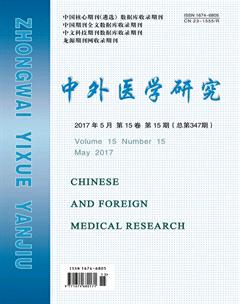PM2.5濃度在小兒支氣管哮喘中的臨床分析
任燕

【摘要】 目的:探討大氣顆粒物(PM2.5)濃度在小兒支氣管哮喘中的作用,為哮喘發病機制提供臨床指導。方法:選取宜賓市第一人民醫院門診及住院患兒(2014年2月-2015年6月),分為兩組,大氣顆粒物(PM2.5)高濃度組100例,大氣顆粒物(PM2.5)低濃度組100例;觀察兩組患兒外周血的嗜酸性粒細胞計數數量(EOS值)、哮喘發病率、1個月內再次發病率、3個月再次發病率、半年再次發病率。結果:大氣顆粒物(PM2.5)高濃度組較大氣顆粒物(PM2.5)低濃度組EOS值、發病率、1個月內再次發病率、3個月再次發病率、半年再次發病率明顯高,差異有統計學意義(P<0.05)。結論:大氣顆粒物(PM2.5)能使哮喘患兒EOS值、短期內再次發病率明顯升高。
【關鍵詞】 大氣顆粒物(PM2.5); 小兒哮喘; 臨床分析
doi:10.14033/j.cnki.cfmr.2017.15.084 文獻標識碼 B 文章編號 1674-6805(2017)15-0151-03
Clinical Analysis of PM2.5 Concentration in Infantile Asthma/REN Yan.//Chinese and Foreign Medical Research,2017,15(15):151-153
【Abstract】 Objective:To investigate the effect of PM2.5 concentration in infantile asthma to provide clinical guidelines for the treatment of asthma pathogenesis.Method:Selected the First Peoples Hospital of Yibin outpatients and hospitalized children(February 2014-June 2015) and divided into two groups.Atmospheric particulate matter(PM2.5) in children with high concentrations group of 100 cases.Atmospheric particulate matter(PM2.5) in children with low concentrations of 100 cases.Observed the incidence of asthma in two groups of children,the number of eosinophil counts in peripheral blood(EOS value),morbidity,incidence of morbidity in one month,three months,six months again.Result:Compared with atmospheric particulate matter(PM2.5) in children with low concentrations,EOS value,morbidity,incidence of morbidity in one month,three months,six months again increased more significant than atmospheric particulate matter(PM2.5) in children with high concentrations,the differences were statistically significant(P<0.05).Conclusion:Atmospheric particulate matter(PM2.5) can significantly increase the EOS value and the incidence of asthma in children once again in the short term.
【Key words】 Atmospheric particulates(PM2.5); Infantile asthma; Clinical analysis
First-authors address:Yibin City Fourth Peoples Hospital,Yibin 644002,China
小兒支氣管哮喘為兒科呼吸道常見病及多發病,其典型臨床癥狀是在可逆性氣流受限,常見臨床表現為反復發作喘息、咳嗽、混合型呼吸困難,常在夜間或凌晨發作加劇。隨著病情進展對患兒身體發育造成極大影響[1-4]。目前對小兒哮喘發病機制尚不明確,但近期研究顯示,大氣污染同小兒哮喘發病有相關性。本研究旨在研究大氣顆粒物(PM2.5)與小兒支氣管哮喘關系。
1 資料與方法
1.1 一般資料
PM2.5高濃度組選取宜賓市宜賓縣224廠(火力發電廠)周圍100例兒童,男61例,年齡(5.4±2.5)歲,女39例,年齡(3.5±3.4)歲;PM2.5低濃度組選取宜賓市蜀南竹海周圍100例兒童,男60例,年齡(5.1±3.5)歲,女40例,年齡(3.6±2.8)歲。根據2008年兒童支氣管哮喘診斷與防治指南中華醫學會兒科學分會呼吸學組制訂的兒童哮喘診斷標準,患兒臨床癥狀上:均有反復咳嗽、喘息、有的患者痰呈黃色,查體:呼吸快,R>30 次/min,雙肺可聞及哮鳴音,局部濕啰音;兩組一般資料差異無統計學意義(P>0.05),具有可比性。
1.2 方法
使用PM2.5濃度檢測儀(使用手持式PM2.5粉塵檢測儀,美國MetOne粉塵檢測儀831,型號:831,品牌:MetOne)測定宜賓縣224電廠及宜賓市蜀南竹海周圍空氣中的PM2.5濃度,觀察1年兩組患兒外周血的嗜酸性粒細胞計數數量[儀器:貝克曼庫爾特Z2全自動細胞分析計數儀,型號:Z1(Dual)雙域值型)]、發病率、1個月內再次發病率、3個月再次發病率、半年再次發病率。
1.3 統計學處理
統計軟件為SPSS 18.0,計量資料以(x±s)表示,符合正態分布采用t檢驗,計數資料以率(%)表示,采用字2檢驗,P<0.05為差異有統計學意義。
2 結果
大氣顆粒物(PM2.5)高濃度組較大氣顆粒物(PM2.5)低濃度組EOS值、發病率、1個月內再次發病率、3個月再次發病率、半年再次發病率明顯高,差異有統計學意義(P<0.05),見表1。
3 討論
隨著環境污染嚴重加重,呼吸系統疾病特別是哮喘發病率呈進行性上升趨勢[2-6]。小兒哮喘通常是多種炎癥介質及多種炎癥細胞造成的一種慢性氣道疾病,也是危害當代兒童生理健康的常見病之一,遷延不愈,易影響患兒的日常生活與學習,甚至因病情進展,可引起氣道重塑,嚴重損害到患兒肺功能,使患兒生活質量下降,給社會造成巨大社會負擔[2,4,6-10]。根據國內外大量研究顯示,大氣中顆粒物與哮喘發病率有密切聯系,特別是空氣中PM2.5濃度,PM2.5是空氣中直徑小于2.5 μm,可直接進入肺泡,不易排出,進入肺泡后可以使機體產生氧化應激,使氧與抗氧化防御系統失調,產生一系列反應綜合征;如激活信號分子Nrf2調節免疫防御的信號通路;誘發肺泡細胞上線粒體傳導復合物Ⅲ產生活性氧,使組織細胞損傷[2,4,7-12];其次,PM2.5進入小兒肺泡細胞后可分泌大量細胞因子,如IL-6、IL-8、IL-32、IL-1等,產生炎癥反應綜合征[6,8,10-14];再次PM2.5進入肺泡細胞后,可使肺泡細胞核酸修復功能受損,如引起DNA融合,線粒體和紡錘體損害引起染色體過早后阻止染色體進入有絲分裂,引起DNA損傷、表達及修復紊亂;可使機體產生大量高特異性IgE,可使巨噬細胞活性表達增加;產生大量趨化因子及炎癥介質引起小兒哮喘發作[3,5,6,8,11,14-15]。
通過本研究顯示,大氣中PM2.5濃度升高可使哮喘患兒的外周血嗜酸性粒細胞數升高,發病率升高,1個月內再次發病率、3個月再次發病率、半年再次發病率呈升高趨勢,經SPSS統計軟件分析,差異有統計學意義(P<0.05)。提示PM2.5濃度升高可引起小兒哮喘急性發作,因此必須加強對環境中PM2.5濃度監測。本試驗不足之處在于標本少,觀察指標少,有待下一步深入研究。
參考文獻
[1]中華醫學會兒科學分會呼吸學組.兒科支氣管哮喘診斷與防治指南[J].中華兒科雜志,2008,46(10):745-753.
[2]全國兒科哮喘防治協作組.第三次中國城市兒童哮喘流行病學調查[J].中華兒科雜志,2013,51(10):729-735.
[3] Papadopoulos N G,Arakawa H,Carlsen K H,et al.兒童哮喘國際共識[J].中華實用兒科臨床雜志,2014,29(1):67-76.
[4]胡亞美,江載芳.諸福棠實用兒科學[M].第7版.北京:人民衛生出版,2008:1171-1172.
[5]蔡曉紅,胡云良,陳小芳,等.小兒哮喘不同時期氣道炎癥改變的探討[J].臨床兒科雜志,2002,20(9):550-551.
[6] Peng R D,Bell M L,Geyh A S,et al.Emergency admissions for cardiovascular and respiratory diseases and the chemical composition of fine particle air pollution[J].Environ Health Perspect,2009,117(6):957-963.
[7] Thompson A J,Shields M D,Patterson C C.Acute asthma exacerbations and air pollutants in children living in Belfast,Northern Ireland[J].Arch Environ Health,2001,56(3):234-241.
[8] Wong G W,Ko F W,Lau T S,et al.Temporal relationship between air pollution and hospital admissions for asthmatic children ifl Hong Kong[J].Clin Exp Allergy,2001,31(4):565-569.
[9] Ko F W,Tam W,Wong T W,et al.Effects of air pollution on asthma hospitalization rates in different age groups in Hong Kong[J].Clin Exp Allergy,2007,37(9):1312-1319.
[10] Ghio A J.Mechanism of asthmatic exacerbation by ambient air pollution particles[J].Expert Rev Respir Med,2008,2(1):109-118.
[11] Erbas B,Kelly A M,Physick B,et al.Air pollution and childhood asthma emergency hospital admissions:Estimating intra-city regional variations[J].Int J Environ Health Res,2005,15(1):11-20.
[12] Gouveia N,Fletcher T.Respiratory diseases in children and outdoor air pollution in Sac Paulo,Brazil:a time series analysis[J].Occup Environ Med,2000,57(7):477-483.
[13] Park M,Luo S,Kwon J,et al.Effects of air pollution on asthma hospitalization rates in different age groups in metropolitan cities of Korea[J].Air Qual Atmos Health,2013,6(3):543-551.
[14] Lin M,Chen Y.Burnett R T,et al.The influence of ambient coarse particulate matter on asthma hospitalization in children:case-crossover and time-series analyses[J].Environ Health Perspect,2002,110(6):575-581.
[15]張娟娟,汪東海,代繼宏.大氣可吸入性顆粒物暴露與兒童哮喘顯著關聯:基于22篇觀察性研究的分析[J].中國循證兒科雜志,2015,10(5):337-344.

